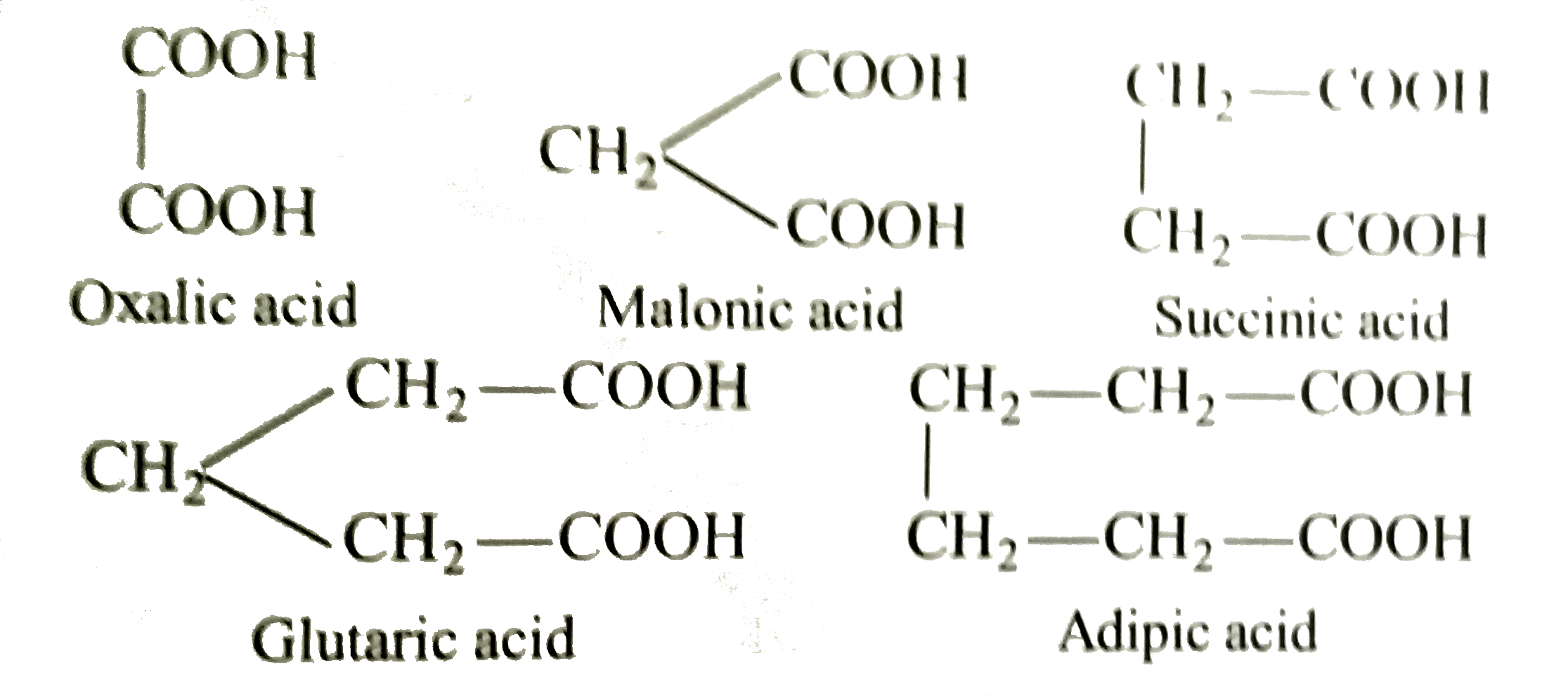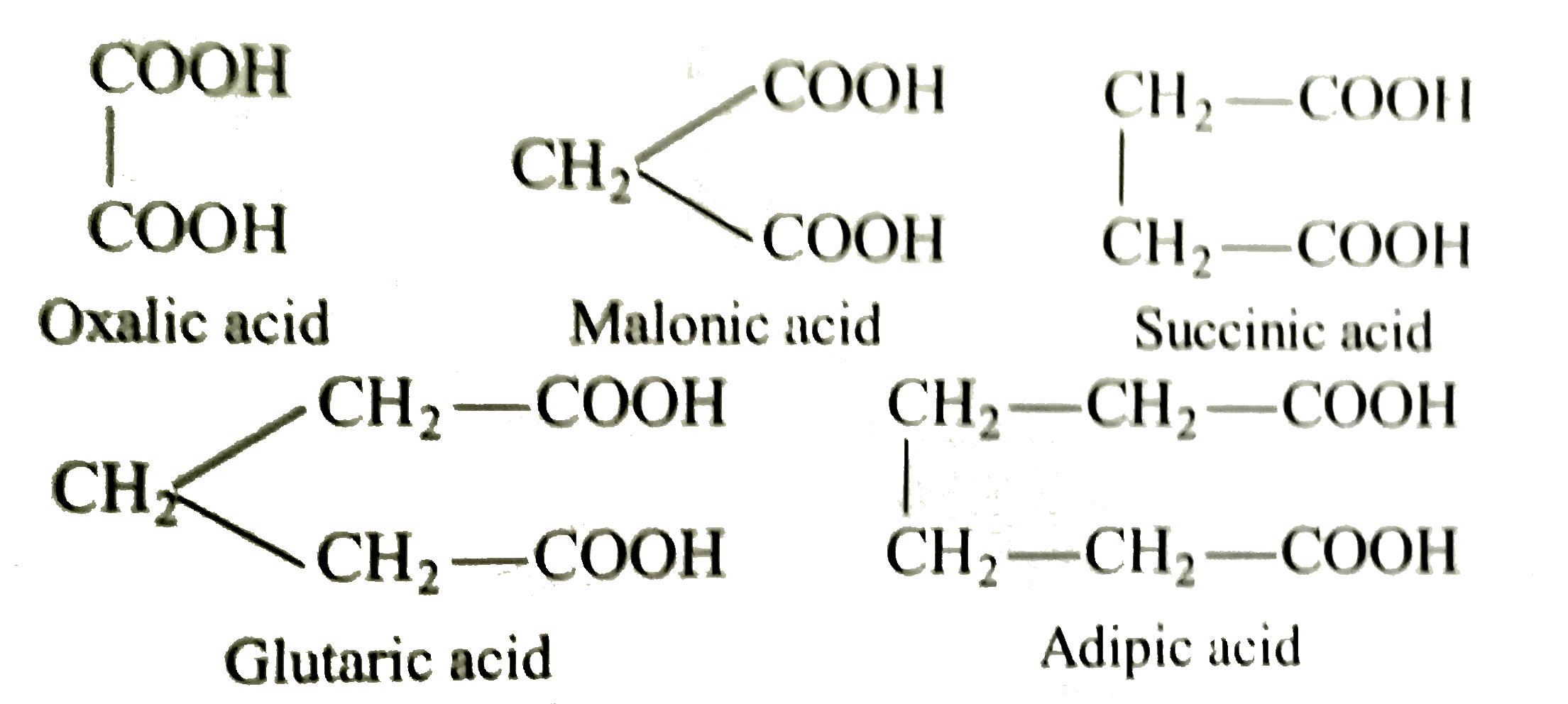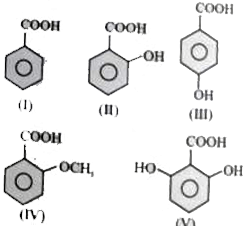Dicarboxylic acids have two carboxylic groups, e.g.,

Acidity of dicarboxylic acid depends upon the stability of intermediate ion and upon the distance between two carboxylic groups. Shorter the distance between two carboxylic groups, greater is the acidic character. Melting point of these acids depends on the symmetry. Greater the symmetry, higher will be the melting point.
Dicarboxylic acids on heating give monocarboxylic acid allkanes, cyclic ketones depending on the conditions
Which of the following dicarboxylic acids, will give monocarboxylic acid on heating ?
Malonic acid
Succinic acid
Glutaric acid
Adipic acid
The correct Answer is:A
Step by step video, text & image solution for Dicarboxylic acids have two carboxylic groups, e.g., Acidity of dicarboxylic acid depends upon the stability of intermediate ion and upon the distance between two carboxylic groups. Shorter the distance between two carboxylic groups, greater is the acidic character. Melting point of these acids depends on the symmetry. Greater the symmetry, higher will be the melting point. Dicarboxylic acids on heating give monocarboxylic acid allkanes, cyclic ketones depending on the conditions Which of the following dicarboxylic acids, will give monocarboxylic acid on heating ? by Chemistry experts to help you in doubts & scoring excellent marks in Class 12 exams.
Topper's Solved these Questions
- BOOK - OP TANDONCHAPTER - CARBOXYLIC ACIDS AND THEIR DERIVATIVESEXERCISE - Integer4videos
CARBOXYLIC ACIDS AND THEIR DERIVATIVES
- BOOK - OP TANDONCHAPTER - CARBOXYLIC ACIDS AND THEIR DERIVATIVESEXERCISE - Brain storming problems30videos
CARBOXYLIC ACIDS AND THEIR DERIVATIVES
- BOOK - OP TANDONCHAPTER - BASIC PRINCIPLES OF ORGANIC COMPOUNDS (MECHANISM OF ORGANIC REACTIONS)EXERCISE - SINGLE INTEGER ANSWER TYPE QUESTIONS4videos
BASIC PRINCIPLES OF ORGANIC COMPOUNDS (MECHANISM OF ORGANIC REACTIONS)
- BOOK - OP TANDONCHAPTER - CHEMICAL KINETICSEXERCISE - LINKED COMPRESHENSION TYPE QUESTIONS ( SECTION-VI)4videos
CHEMICAL KINETICS
Similar Questions
Which of the following is a dicarboxylic acid ?
View SolutionDicarboxylic acids have carboxylic groups e.g.
HOOC-COOH,oxalic acid
HOOC−CH2−COOH-Maloic acid
HOOC-(CH2)3-COOH-Glutaric acid
HOOC,(CH2)4-COOH,-Adipic acid
Acidity of dicarboxylic acids depends upon the stabillity of intermediate ion and upon the distance between two carboxylic groups. shorter the distance between two carboxylic groups, greater is the acididc character. Melting point of the acids depends on the symmetry. greater the symmetry, higher will be the mp. Dicarboxylic acids on heating give monocarboxylic acid, alkanes, cyclic ketones dependings on the conditions.
Sodium adipate on electrolysis gives :View Solution
Knowledge Check
- Question 1 - Select One
Dicarboxylic acids have two carboxylic groups, e.g.,

Acidity of dicarboxylic acid depends upon the stability of intermediate ion and upon the distance between two carboxylic groups. Shorter the distance between two carboxylic groups, greater is the acidic character. Melting point of these acids depends on the symmetry. Greater the symmetry, higher will be the melting point.
Dicarboxylic acids on heating give monocarboxylic acid allkanes, cyclic ketones depending on the conditions
Which of the following has highest melting point?AMaleic acidBFumaric acidCSuccinic acidDOxalic acid - Question 2 - Select One
Dicarboxylic acids have carboxylic groups e.g.
HOOC-COOH,oxalic acid
HOOC−CH2−COOH-Maloic acid
HOOC-(CH2)3-COOH-Glutaric acid
HOOC,(CH2)4-COOH,-Adipic acid
Acidity of dicarboxylic acids depends upon the stabillity of intermediate ion and upon the distance between two carboxylic groups. shorter the distance between two carboxylic groups, greater is the acididc character. Melting point of the acids depends on the symmetry. greater the symmetry, higher will be the mp. Dicarboxylic acids on heating give monocarboxylic acid, alkanes, cyclic ketones dependings on the conditions.
Which of the following dicarboxylic acid is used in the manufactures of nylon-6,6?ASuccinic acidBGlutaric acidsCadipic acidDOxalic acid - Question 3 - Select One
Dicarboxylic acids have carboxylic groups e.g.
HOOC-COOH,oxalic acid
HOOC−CH2−COOH-Maloic acid
HOOC-(CH2)3-COOH-Glutaric acid
HOOC,(CH2)4-COOH,-Adipic acid
Acidity of dicarboxylic acids depends upon the stabillity of intermediate ion and upon the distance between two carboxylic groups. shorter the distance between two carboxylic groups, greater is the acididc character. Melting point of the acids depends on the symmetry. greater the symmetry, higher will be the mp. Dicarboxylic acids on heating give monocarboxylic acid, alkanes, cyclic ketones dependings on the conditions.
Which of the following is the most acidic ?AOxalic acidBMaloic acidCSuccinic acidDAdipic acid
Which of the following acids are dicarboxylic acids ?
View SolutionWhich of the following dicarboxylic acids gives a cyclic anhydride on heating?
View SolutionWhich dicarboxylic acid on heating given monocarboxylic acid with two carbon aotoms ?
View SolutionWhich of the following carboxylic acids is most acidic in character-
View SolutionThe correct order for the acidic character of the following carboxylic acids is :
 View Solution
View Solution

